Broody hens: 7 ways to break them, 6 ways to prevent them and can you just leave them?

You can’t always stop a hen becoming broody but there are a few steps you can take to make it less likely.
Table of Contents
The measure you take are not likely to stop the really determined chickens but you can put some off.
When a hen becomes broody, it means that she wants to become a mum and hatch her eggs and raise some chickens.
The combination of lengthening days and the hormone prolactin are responsible for the changes you see in a broody hen. She may even steal eggs from other hens.
Signs of broodiness in chickens:
There are a few signs and clues that a hen is or is becoming broody.
Below: A grumpy and bad tampered broody hen.
- Clutch laying and hiding eggs – A chicken that wants to be a mum might start hiding eggs in difficult to get to places like hedges and bushes.
- Fluffiness – She is likely to fluff out her feathers to make herself look bigger and her tail may be fanned out like a turkeys.
- Noises – Broody hens have a particular vocabulary and manner about them. Its very fussy and determined. Growling and grumbling.
- Grumpiness – They will be very bad tempered and take it out on you and the other hens.
- Plucked breast feathers in the nest and a visible brood patch – This is the bare patch on the breast, it becomes visible and the feathers will be used to make a nest.
- Sitting flat in a nest like a limpet does on the rocks – The hens are very flat in the nest and sit completely still.
- Broody poop's – Huge is about all I can say on this. They are massive. And smelly.
- Aggressive behaviour - This is a step up from the normal squabbles and can be explosive and nasty and may be directed towards humans as much as other hens.
The quicker you catch it the easier it will be to break as a general rule.
A broody hen will take a break from laying eggs but they tend to get back to it within about 6 weeks and I reckon they lay a bit later in the season when they’ve been broody so you should still get the same number of eggs in the long run.
To prevent one of your girls from becoming broody, it’s important to take a few precautions. Collecting your eggs on a regular basis is one of the best safeguards you can have against hens becoming broody. Leaving eggs out overnight in the nesting boxes will encourage broodiness in hens.
What happens if you don't break a broody hen?
You do have to deal with a broody hen, either by giving her eggs to hatch or by breaking her off the nest.
I have tried to leave broody hens alone but it does not work. She will either sit on the empty nest until she begins to suffer and may even die or she will be disruptive in the flock and try to take nests with eggs in from other hens.
When a chicken decides she wants to raise a brood, it is not a conscious decision but a hormonal one.
A hens condition will suffer quite badly during the 21 days of incubation and they can lose 10% of their body weight.
If you don't deal with a broody hen you could:
- Two or three broodies can affect your egg supply.
- Find yourself with partially incubated eggs in your nests.
- Get broken eggs and egg eating hens.
- Lose hens if they find their own nests.
- You may already have a mum on eggs or with chicks and they may fight and kill the chicks or one mum may be enough for you.
- A bad tempered broody can be very disruptive amongst the flock and cause all sorts of squabbles.
- When brooding the eat and drink much less than normal and will lose condition and dehydrate.
- A hen sat on unfertilised eggs may die as they never hatch.
- She may become sick or infested with parasites or become a target for predators.
- Not all hens make good mothers and it is pointless using them to raise chicks.
It may seem a strange idea as most hens will give up being broody eventually but in my opinion it is kinder to deal with it straight away and have her back to laying in five or six weeks.
I have found that just leaving broody hens alone may take three months before things return to normal.
Should you break a broody hen?
You should break a broody hen if you are not going to use her to hatch eggs.
A broody is controlled by her hormones and she may just sit on a nest until she wastes away. I actually had this a few years ago, one of my Silkies wandered off and sat on a clutch of eggs in a hedge.
Below: Having a broody hen around is very hard work.
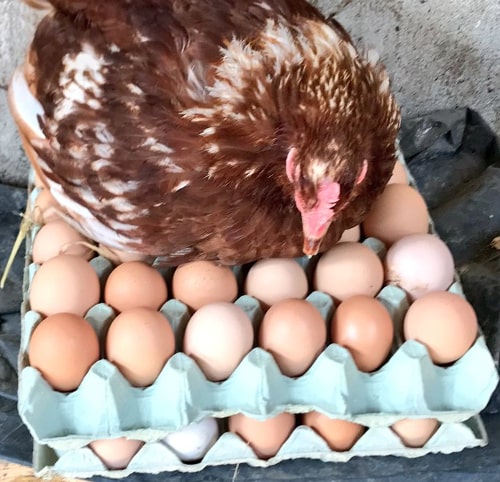
Unfortunately her eggs were not fertile and she died on the nest. I only discovered it a few weeks later when I was cutting the overgrowth back.
Alternatives to breaking a broody hen:
There is one alternative to breaking a broody and that is to give her eggs to sit on chicks to look after.
Give her a single sexed chick to raise. You can get these from tractor supply or a farm or friends that raise chickens. A single chicks will keep her occupied and get her of the nest to look after it in a day or so.
Below: Leaving broody poultry has all sorts of implications as they have a habit of disappearing to nest.
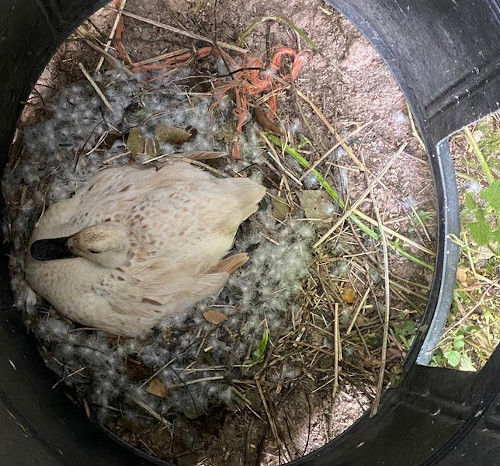
Essentially a hen gets the urge to sit on eggs for 21 days and as any chicken keeper will tell you they can be quite stubborn about it. A good broody can be a real bonus if you want to raise youngsters but they are a pain in the arse if you do not.
Below: The urge to raise a family is quite natural chicken behaviour.
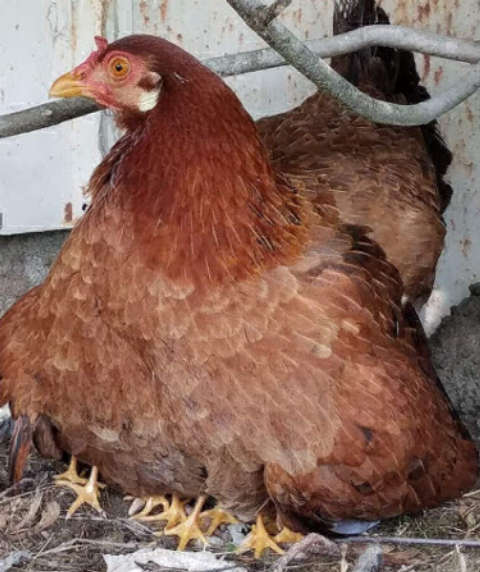
6 ways you can stop hens becoming broody:
To prevent one of your girls from becoming broody, it’s important to take a few precautions.
Collecting your eggs on a regular basis is one of the best safeguards you can have against hens becoming broody. Leaving eggs out overnight in the nesting boxes will encourage broodiness in hens.
- Choose a breed that is less likely to become broody. If you have a breed of hen known for broodiness, then you may notice more of your hens going individually broody. Breeds like Silkies are known for becoming broody at the drop of a hat.
- Collect the eggs. If you collect the eggs a few times in the morning it disturbs any hens that might be getting the idea about sitting. Also they are more likely to sit if there is a clutch of eggs in a nest so removing them helps here. It also keeps the hens moving around.
- Another tip is to lock up the nesting boxes at night. This can be done manually if you only have a handful of backyard chickens to look after. Preventing your hens from sleeping in the nesting boxes (especially sleeping in the nesting boxes on eggs that haven’t been collected) will help prevent broodiness from setting in.This also helps prevent parasites and infections from setting in, since the parasites are more active at night and prefer the dark, warm recesses of nesting boxes. It is as simple as filling the nest box with a cardboard box.
- Making your nest boxes with a wire mesh floor and good airflow will help prevent brooding tendencies. Your boxes should also have a sufficiently slanted floor to allow the eggs to gently roll away without the risk of them breaking. If you are building wire-bottomed nesting boxes, stack them in a step formation so that droppings and debris don’t fall into the cages below.
- Know when it happens. Broody behaviour is more common in the spring as this is the natural time for raising young. In my experience it is also most common in a hens second year.
- Distractions. Give your hens something to do during the day to keep them occupied. Change their diet or introduce rotten logs with bugs that they can pick through, or bedding they can dig in. Don’t forget a good dust bath or a hanging cabbage.
Below: Broody hens often fight with other flock members.
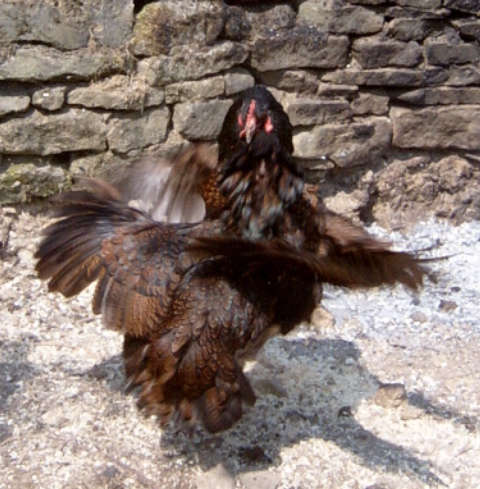
A broody hen can be astonishingly violent and it is one of the few times you are likely to see a hen really fight.
By combining all these tactics, you will have a much better chance at preventing a hen from becoming broody, and of encouraging her out of it if she does.
Hens that have gone broody may not even be sitting on eggs. They may sit on rocks or on a nest with no eggs. I had one recently sat on three golf balls in a plant pot.
Also, if your hen does have a nest with eggs but you have no rooster, your hen will not know that the eggs aren’t fertile. They will just go rotten under her and explode in a smelly mess.
She may be in a temper when she becomes broody and plucks at her feathers, hiss, or peck at you if you try to move. She may even become aggressive towards other hens that approach her nest.
As you may have guessed, this behaviour is not beneficial unless you are actually attempting to hatch chicks. Your hen will become stressed and neurotic when her eggs don’t hatch—and you will be down a laying hen!
7 ways to deal with broody hens:
It can be very difficult to break some hens. I do it a lot very early in the season so the hens have better weather when they raise their youngsters. This year I would have hens trying to raise youngsters in 4 foot of snow if I had left them to it first time around.
So it is too late and your lovely hen has turned into a growling, hissing and spitting lump that seems to be glued to the nest.
Dealing with broody hens requires firm resolve and it can take up to a week to break a broody hen.
If your hen has already gone broody or is showing signs of broodiness, you will want to isolate her from the flock as the disruption can affect the production of eggs.
You should deal with a broody hen and they shouldn’t just be left to sit. They will lose condition and might end up with parasites or all sorts of issues.
- The cage method.
The best way to do this is to put her in an elevated wire mesh cage with all-around airflow. I raise mine up on 4 ordinary house bricks, one at each corner. Give her food, water and a perch but no nest and then wait 3 or 4 days and your hen should start coming around. A large dog crate will work really nicely.
Below: Three days in a crate is normally enough to break a broody hen.

It must be covered so the bird is not in full sun but it should be brightly lit with plenty of fresh air. It’s also important to keep your cages off the ground so that parasites, insects, and rodents don’t attempt to find refuge in the bedding and corners.
- Being annoying.
This involves turfing the hen of the nest at every opportunity and is sometimes known as the boomerang method. The quicker you catch her the more chance it has of success. Remove her eggs and make sure she doesn’t steal anyone else's.
You need to be more stubborn than the hen which can be a challenge and you will need to cover the nest boxes at night.
- The strange rooster method.
The strange cockerel is a very effective method and was given to me by an old timer, he told me that a day or two with a fresh rooster will turn a broody hen. This is for the obvious reason that he will pester the hen and chase her around and get her to submit to him.
It seems being dominated by a new rooster is enough to turn a broody. This method obviously only works if you have a spare cockerel or can borrow one.
- 4. The wet belly method.
The water method uses cool but not cold water to cool off the chickens brood area. Get a bucket of water about 30 degrees C and float the chicken in it for a few minutes. Take her off the nest gently and lower her into water. She will be cooled off and trundle off to preen herself and hopefully forget about the nest.
Please note this is not the handful of ice in the nest box method, I think that is cruel and would never endorse it at all.
- 5. The new house.
A bare empty shed with no comforts, just food and water and a perch.
- 6. Let her have a fertile egg or two.
Give her a few fertile eggs and hatch a few chicks out for someone else. You can have the fun of looking after babies and send them away when the become naughty teenagers.
- 7. Loan her out.
I regularly borrow or lend a broody hen to or from someone. Determined sitters are worth their weight in gold to some people who prefer to raise young the natural way with hens.
Which breeds of chickens are prone to broodiness?
Some strains of chickens are more prone to broodiness. This is a great thing if you’re looking to grow your flock and want a strain with good mothering instincts. Silkies, Cochins, Orpingtons, and Brahmas all have a tendency towards broodiness.
Bantams tend to be more broody in my experience, I have both bantam and large fowl Light Sussex and the smaller is definitely more broody.
I have always been surprised by how much Game birds become broody.
My Andalusians never seem to go broody and hybrids usually never go either.
Below: Hens go broody in some funny places, this one is in an old water tank.
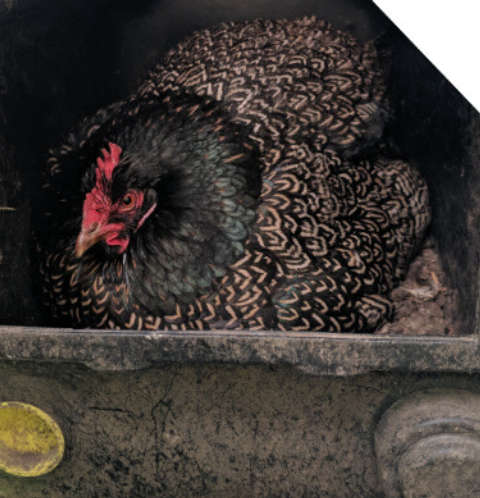
My Barnevelders are not much of a "broody" breed but a few go every year. This one has escaped to an old water tank in a loft space.
However, it’s important to remember that this does make these a “bad” breed. In fact, these breeds are marvellous for expanding your flock and are a boon to many farmers.
If you do have a strain of chicken prone to broodiness, there are a couple steps you can take to help prevent brooding from setting in. The design of your nesting boxes is one of the more important things you should keep in mind to prevent broodiness.
